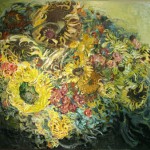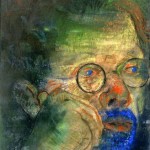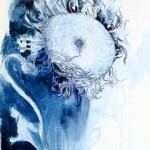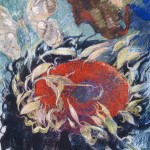“My drawings inspire and do not define themselves. They determine nothing. They place us, just as music does, in the ambiguous world of the indeterminate. They are, then, without further explanation which cannot be more precise, the repercussions of human expression placed by permitted fantasy, in a play of arabesques, where, I do believe, the action which will be derived in the mind of the spectator, will incite him to fictions of great or small significance according to his sensitivity, and according to his imaginative aptitude for enlarging everything or belittling it.”
Odilon Redon
Like a Proustian sweet, the twisted and decaying form of the sunflower opens the gates of remembrance and reverie for Jimmy Wright. And while this overly familiar and extremely popular subject may at first recall those golden bouquets of Van Gogh, the delicate moods of Wright’s lush pastels and paintings of sunflowers more closely parallel Gauguin’s evocative color and symbolism. In his sensual and at times melancholic interpretation of the subject, he is even closer to the sunflowers of Egon Schiele and the chrysanthemums of Piet Mondrian. However, the romantic and at times phantasmagoric character acquired by Wright’s dried blossoms recalls, more than anything, the apparitions, myths, and lyrical mysteries in the pastels and decorative screens by Odilon Redon, and artist he greatly admires. Still, it must be kept in mind that in Wright’s oeuvre this summer flower is best considered as a talisman and reliquary object rather than a representation of botanical fact. His metaphoric interpretations of sunflowers are loaded with innuendo and enigma, and each variant probes a subtly different emotional facet.
One aspect is a given: Wright is a gifted draftsman. His precocious skill was recognized quite early and the strength of Wright’s paintings, pastels, and drawings center on this facility. Evidence of this is abundantly demonstrated in his earlier Portrait of the Artist in 18 th Century Glasses and recent Self Portrait with Green Hand, now in the collection of The Metropolitan Museum of Art. But Wright does not pursue the descriptive verisimilitude of the academician; instead his drawing tilts toward personal, inventive, and expressive mean. Less evident, due to their apparent spontaneity, improvisational shifts, and gestural fluidity, is fact that Wright’s pastels and paintings are solidly crafted. He seems instinctively aware of the inherent characteristic of his materials and their various grounds, from vellum to linen, which is readily apparent in his drawings and paintings.
Several of the large drawings of sunflowers are rendered with oil based lithographic crayons. In these, Wright’s vigorous curvilinear line converts the dry petals, bud case, and withering foliage into anthropomorphic, Art Nouveau abstractions reminiscent of Karl Blossfeldt’s totemic photographs of plants and Louis Sullivan’s elaborate, leafy reliefs. The latter most likely would have left a lingering impression from Jimmy Wright’s years in Chicago.
Some of the pieces depicting singular flowers, the Blue & White watercolor on vellum, the pastel and watercolor Blue & White, Blue & Black with its striated stains, and the pastels Blue & Pale Yellow and Sunflower/Water on Lanaquarelle (a heavy, smooth surfaced cold press paper) illustrate Wright’s adaptive, open ended exploration of a variety of media and grounds, including spraying the pastels with water and the frequent use of Golden Pastel Medium, a pumice and acrylic vehicle. When washed over the dry pigments the medium converts them to a transparent stain while simultaneously providing a gritty tooth for further redrawing. Such spritzing, scrubbing, and overworking can be seen in both Sunflower/Water and Blue & Pale Yellow. These solitary sunflowers, ranging from a pale, floating ghost of an image to twisting, turbulent skeletal remains, are his most tender and poetic images.
There is an assortment of dried sunflowers in Wright’s windowless studio, but they are not arranged as bouquets. Instead, they lie in fragments, like the relics of saints, on his worktable. Others are mounted in a shadow box on the wall, and there is a stack of photographs of botanical remnants next to his trays of chromatically arranged pastels. On the walls of his living quarters there are several framed collections of butterflies and moths. Like the decayed blossoms, these fragile winged fantasies serve as reminders and reflections of his recent emotional past and his agrarian upbringing in Tennessee and Kentucky. They too appear occasionally in his drawings and paintings.
In regard to Wright’s Southern roots, there is also that region’s long and inescapable tradition of music and storytelling, so rich with parables, symbols, and ironies, that it appears to be bred in the bone. Complimenting these factors was Wright’s education at the Art Institute of Chicago, where Ray Yoshida proved to be a strong influence. Yoshida’s abstract paintings contain illusive figural hints and his open-ended classroom pedagogy shaped a broad assortment of abstract and figurative painters, including imagists such as Jim Nutt and Roger Brown. Unlike the adherence to the tenets of Clement Greenberg’s formalism in many of the East Coast art departments in the mid-sixties; the art in Chicago, backed up by the stunning Institute collection, the exhibits at the Hyde Park Art Center, and the bent of its commercial galleries, centered on the imaginative and inventive side of figural sculpture and painting. It is no accident that the elegant, plant-like sculptures of Richard Hunt, whimsical flights of fancy by Ellen Lanyon, sharp-witted constructions by Red Grooms, and the heightened realism of Jack Beal and Richard Estes have all emanated from Chicago rather than New York.
Jimmy Wright’s large canvases, such as Sage and Grey Head, serve to illustrate the importance he placed on scale and reflect his ability to continually adapt his working procedure to the intrinsic character of the medium, whether it is watercolor, pastel, or oil. The paintings take on the fluidity and physicality of gestural abstraction and are filled with the traces of numerous shifts and changes of color, form and character. Also, there are indications that Wright’s pastel and oils have been drawn on from different directions and that his images emerge gradually. Remnants of many rejected moves can be seen just below their surfaces, indicating that there is no straight, procedural course in his fusion of subject, mood, and emotional content.
Like his oil paintings, the more developed pastels press toward the uncertainty and improvisation of abstraction – just as Leonardo da Vinci noted staring at clouds and ceiling cracks until animals and figures appear; a practice taken up by Claude Lorraine, the Surrealists, and Dadaist, and one we have all learned from Rorschach’s blots and then begin picking out vegetal reminders in the streaks, smears, and stains. In Yellow Sky and Blue Bloom bits and pieces of the sunflower appear to have worked their way to the surface, take on a different form. Some of these fragments sink beneath the layers of pumice stain and pastel. Then petals reappear and stretch into ringlets and ribbons while the thick, seed filled hearts take on the rich cobalts, greens, and violets of Redon’s night fantasies. We are left with suggestive icons of a dreamlike species that flutters continually between blossom, insect, and sea creature.
These recent works culminate in the elaborate, heavily worked, and highly agitated Flames and Moth to Flames, which are images that provide more substantial allusions to Wirght’s personal iconography. With the flower, there is the ongoing cycle of growth, death, and rebirth. The sunflower, a talisman of late summer that continually turns to face the warm light of the sun, now emanates heat and flames. In the oils and pastels it shifts symbolically from sun worshipper to the sun itself as the heart of the cosmos and a light that wars continually against the darkness. Wright’s use of the Lunar Moth in Moth to Flames is not accidental. This winged creature of the night that is perennially, obsessively, and recklessly seduced by light and fire has represented the psyche in various cultures for centuries.
Wright has instilled the sunflower with the jarring, grinding complexities of our time, given it the semblance of his own vision, and then used it as both catharsis and poetry. Formally and expressively, his drawings, pastels, and paintings range from the open turbulence and cacophony of our days to the hushed moments and secret dreams of the night. Like nocturnes, these withered blossoms carry without words the profoundly private shadings of his persona and convey his most tender and anxious musings.
John Arthur
This essay was published on the occasion of the exhibition held at DC Moore Gallery June 12 through July 12, 2001.



